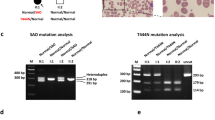Abstract
Anion exchanger 1 (AE1 or SLC4A1) mutations have been reported to cause distal renal tubular acidosis (dRTA), a disease characterized by impaired acid excretion in the distal nephron. We have recently demonstrated homozygous AE1 G701D mutation as a common molecular defect of autosomal recessive (AR) dRTA in a group of Thai pediatric patients. In the present work, we discovered a de novo heterozygous AE1 R589C mutation, previously documented in inherited autosomal dominant (AD) dRTA. Arginine at this position is conserved in all vertebrate AE proteins indicating its functional importance. Three different mutations at this position (R589C, R589H, and R589S) were all found in AD dRTA and a de novo R589H mutation has previously been recorded. Our report is the second de novo mutation but with a different substituted amino acid. A high prevalence of AE1 R589 mutations and the presence of at least two de novo mutations at this position lead us to propose that codon 589 (CGC) is a "mutational hotspot" of AE1. The mechanism of recurrent mutations probably involves methylation and deamination altering cytosine (C) to thymine (T) in the CpG dinucleotides.

Similar content being viewed by others
References
Rodriguez-Soriano J (2000) New insights into the pathogenesis of renal tubular acidosis—from functional to molecular studies. Pediatr Nephrol 14:1121–1136
Batlle D, Ghanekar H, Jain S, Mitra A (2001) Hereditary distal renal tubular acidosis: new understandings. Annu Rev Med 52:471–484
Chan JCM, Scheinman JI, Roth KS (2001) Renal tubular acidosis. Pediatr Rev 22:277–287
Bruce LJ, Cope DL, Jones GK, Schofield AE, Burley M, Povey S, Unwin RJ, Wrong O, Tanner MJA (1997) Familial distal renal tubular acidosis is associated with mutations in the red cell anion exchanger (band 3, AE1) gene. J Clin Invest 100:1693–1701
Jarolim P, Shayakul C, Prabakaran D, Jiang L, Stuart-Tilley A, Rubin HL, Simova S, Zavadil J, Herrin JT, Brouillette J, Somers MJG, Seemanova E, Brugnara C, Guay-Woodford LM, Alper SL (1998) Autosomal dominant distal renal tubular acidosis is associated in three families with heterozygosity for the R589H mutation in the AE1 (band 3) Cl-/HCO3 - exchanger. J Biol Chem 273:6380–6388
Karet FE, Gainza FJ, Gyory AZ, Unwin RJ, Wrong O, Tanner MJ, Nayir A, Alpay H, Santos F, Hulton SA, Bakkaloglu A, Ozen S, Cunningham MJ, Di Pietro A, Walker WG, Lifton RP (1998) Mutations in the chloride-bicarbonate exchanger gene AE1 cause autosomal dominant but not autosomal recessive distal renal acidosis. Proc Natl Acad Sci U S A 95:6337–6342
Weber S, Soergel M, Jeck N, Konrad M (2000) Atypical distal renal tubular acidosis confirmed by mutation analysis. Pediatr Nephrol 15:201–204
Tanphaichitr VS, Sumboonnaonda A, Ideguchi JH, Shayakul C, Brugnara C, Takao M, Veerakul G, Alper SL (1998) Novel AE1 mutations in recessive distal renal tubular acidosis: loss-of-function is rescued by glycophorin A. J Clin Invest 102:2173–2179
Vasuvattakul S, Yenchitsomanus P, Vachuanichsanong P, Thuwajit P, Kaitwatcharachai C, Laosombat V, Malasit P, Wilairat P, Nimmannit S (1999) Autosomal recessive distal renal tubular acidosis associated with Southeast Asian ovalocytosis. Kidney Int 56:1674–1682
Bruce LJ, Wrong O, Toye AM, Young MT, Ogle G, Ismail Z, Sinha AK, McMaster P, Hwaihwanje I, Nash GB, Hart S, Lavu E, Palmer R, Othman A, Unwin RJ, Tanner MJ (2000) Band 3 mutations, renal tubular acidosis and South-East Asian ovalocytosis in Malaysia and Papua New Guinea: loss of up to 95% band 3 transport in red cells. Biochem J 350:41–51
Ribeiro ML, Alloisio N, Almeida H, Gomes C, Texier P, Lemos C, Mimoso G, Morle L, Bey-Cabet F, Rudigoz RC, Delaunay J, Tamagnini G (2000) Severe hereditary spherocytosis and distal renal tubular acidosis associated with the total absence of band 3. Blood 96:1602–1604
Yenchitsomanus P, Vasuvattakul S, Kirdpon S, Wasanawatana S, Susaengrat W, Sreethiphayawan S, Chuawatana D, Mingkum S, Sawasdee N, Thuwajit P, Wilairat P, Malasit P, Nimmannit S (2002) Autosomal recessive distal renal tubular acidosis caused by G701D mutation of anion exchanger 1 gene. Am J Kidney Dis 40:21–29
Wrong O, Davies H (1959) The excretion of acid in renal disease. Q J Med 28:259–313
Duncan BK, Miller JH (1980) Mutagenic deamination of cytosine residues in DNA. Nature 287:560–561
Perry DJ, Carrell RW (1989) CpG dinucleotides are "hotspots" for mutation in the antithrombin III gene. Twelve variants identified using the polymerase chain reaction. Mol Biol Med 6:239–243
Bottema CD, Ketterling RP, Vielhaber E, Yoon HS, Gostout B, Jacobson DP, Shapiro A, Sommer SS (1993) The pattern of spontaneous germ-line mutation: relative rates of mutation at or near CpG dinucleotides in the factor IX gene. Hum Genet 91:496–503
Pfeifer GP (2000) p53 mutational spectra and the role of methylated CpG sequences. Mutat Res 450:155–166
Bruce LJ, Anstee DJ, Spring FA, Tanner MJA (1994) Band 3 Memphis variant. II. Altered stilbene disulfonate binding and the Diego (Di(a)) blood group antigen are associated with the human erythrocyte band 3 mutation pro854-to-leu. J Biol Chem 269:16155–16158
Jarolim P, Rubin HL, Zhai S, Sahr KE, Liu SC, Mueller TJ, Palek J (1992) Band 3 Memphis: a widespread polymorphism with abnormal electrophoretic mobility of erythrocyte band 3 protein caused by substitution AAG-to-GAG (lys-to-glu) in codon 56. Blood 80:1592–1598
Quilty JA, Li J, Reithmeier RA (2002) Impaired trafficking of distal renal tubular acidosis mutants of the human kidney anion exchanger kAE1. Am J Physiol Renal Physiol 282:F810–F820
Acknowledgements
We thank Thitima Keskanokwong, Nunghathai Sawasdee, Atchara Paemanee, Duangporn Chuawatana, Sumitra Mingkum, and Wilaiwan Keerativutisest for their technical and other assistance. This work was financially supported by grants from the Siriraj Grant for Research Development, the National Center for Biotechnology and Genetic Engineering (BIOTEC), and the Thailand Research Fund (TRF). P.M. is a recipient of the Senior Research Scholar Award of TRF.
Author information
Authors and Affiliations
Corresponding author
Rights and permissions
About this article
Cite this article
Sritippayawan, S., Kirdpon, S., Vasuvattakul, S. et al. A de novo R589C mutation of anion exchanger 1 causing distal renal tubular acidosis. Pediatr Nephrol 18, 644–648 (2003). https://doi.org/10.1007/s00467-003-1112-6
Received:
Revised:
Accepted:
Published:
Issue Date:
DOI: https://doi.org/10.1007/s00467-003-1112-6




